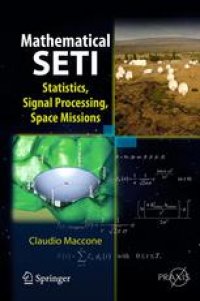
Ebook: Mathematical SETI: Statistics, Signal Processing, Space Missions
Author: Claudio Maccone (auth.)
- Tags: Astronomy Observations and Techniques, Signal Image and Speech Processing, Extraterrestrial Physics Space Sciences, Astrobiology, Statistics for Engineering Physics Computer Science Chemistry and Earth Sciences
- Series: Springer Praxis Books
- Year: 2012
- Publisher: Springer-Verlag Berlin Heidelberg
- Edition: 1
- Language: English
- pdf
This book introduces the Statistical Drake Equation where, from a simple product of seven positive numbers, the Drake Equation is turned into the product of seven positive random variables. The mathematical consequences of this transformation are demonstrated and it is proven that the new random variable N for the number of communicating civilizations in the Galaxy must follow the lognormal probability distribution when the number of factors in the Drake equation is allowed to increase at will.
Mathematical SETI also studies the proposed FOCAL (Fast Outgoing Cyclopean Astronomical Lens) space mission to the nearest Sun Focal Sphere at 550 AU and describes its consequences for future interstellar precursor missions and truly interstellar missions. In addition the author shows how SETI signal processing may be dramatically improved by use of the Karhunen-Loève Transform (KLT) rather than Fast Fourier Transform (FFT). Finally, he describes the efforts made to persuade the United Nations to make the central part of the Moon Far Side a UN-protected zone, in order to preserve the unique radio-noise-free environment for future scientific use.
This book introduces the Statistical Drake Equation where, from a simple product of seven positive numbers, the Drake Equation is turned into the product of seven positive random variables. The mathematical consequences of this transformation are demonstrated and it is proven that the new random variable N for the number of communicating civilizations in the Galaxy must follow the lognormal probability distribution when the number of factors in the Drake equation is allowed to increase at will.
Mathematical SETI also studies the proposed FOCAL (Fast Outgoing Cyclopean Astronomical Lens) space mission to the nearest Sun Focal Sphere at 550 AU and describes its consequences for future interstellar precursor missions and truly interstellar missions. In addition the author shows how SETI signal processing may be dramatically improved by use of the Karhunen-Lo?ve Transform (KLT) rather than Fast Fourier Transform (FFT). Finally, he describes the efforts made to persuade the United Nations to make the central part of the Moon Far Side a UN-protected zone, in order to preserve the unique radio-noise-free environment for future scientific use.
This book introduces the Statistical Drake Equation where, from a simple product of seven positive numbers, the Drake Equation is turned into the product of seven positive random variables. The mathematical consequences of this transformation are demonstrated and it is proven that the new random variable N for the number of communicating civilizations in the Galaxy must follow the lognormal probability distribution when the number of factors in the Drake equation is allowed to increase at will.
Mathematical SETI also studies the proposed FOCAL (Fast Outgoing Cyclopean Astronomical Lens) space mission to the nearest Sun Focal Sphere at 550 AU and describes its consequences for future interstellar precursor missions and truly interstellar missions. In addition the author shows how SETI signal processing may be dramatically improved by use of the Karhunen-Lo?ve Transform (KLT) rather than Fast Fourier Transform (FFT). Finally, he describes the efforts made to persuade the United Nations to make the central part of the Moon Far Side a UN-protected zone, in order to preserve the unique radio-noise-free environment for future scientific use.
Content:
Front Matter....Pages i-lii
Front Matter....Pages 1-1
The statistical Drake equation....Pages 3-72
Letting Maxima do the calculations....Pages 73-109
How many planets for man and aliens?....Pages 111-129
Statistical Fermi paradox and Galactic travels....Pages 131-144
How long does a civilization live?....Pages 145-153
Life-span modeling by finite b-lognormals....Pages 155-184
Civilizations as finite b-lognormals: Mathematical history....Pages 185-213
A mathematical model for evolution and SETI....Pages 215-237
Societal statistics by the statistical Drake equation....Pages 239-246
Cubics of historical recovery....Pages 247-291
Exponential evolution in time as a geometric Brownian motion....Pages 293-331
Front Matter....Pages 333-333
So much gain at 550 AU....Pages 335-347
FOCAL mission to 1,000AU as an interstellar precursor....Pages 349-360
Belt of focal spheres between 550 and 17,000 AU....Pages 361-375
Galactic Internet by star gravitational lensing....Pages 377-392
Extragalactic Internet by black hole gravitational lensing....Pages 393-407
Front Matter....Pages 409-409
A simple introduction to the KLT and BAM-KLT....Pages 411-448
KLT of radio signals from relativistic spaceships in uniform and decelerated motion....Pages 449-469
KLT of radio signals from relativistic spaceships in hyperbolic motion....Pages 471-490
KLT of radio signals from relativistic spaceships in arbitrary motion....Pages 491-516
Front Matter....Pages 409-409
Brownian motion and its time rescaling....Pages 517-534
Maccone first KLT theorem: KLT of all timerescaled Brownian motions....Pages 535-547
Maccone second KLT theorem: KLT of all time-rescaled square Brownian motions....Pages 549-560
Maccone third KLT theorem: Asymptotic KLT of GBM....Pages 561-571
A Matlab code for KLT simulations....Pages 573-584
Front Matter....Pages 585-606
The United Nations and protection of the Moon’s farside....Pages 607-624
Front Matter....Pages 625-656
Epilogue: Evolution, progress, and SETI....Pages 657-657
Back Matter....Pages 659-681
....Pages 683-683